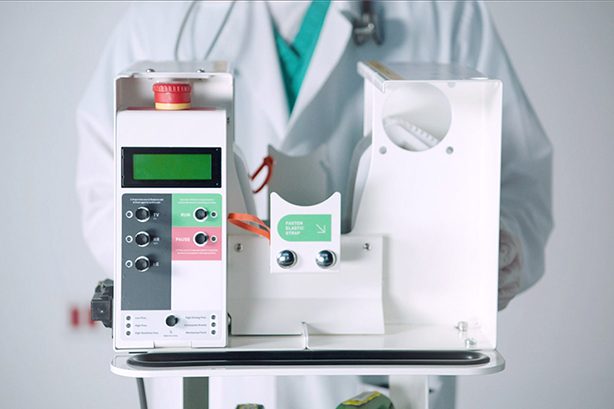By: 10XBeta LLC
Published: 10XBeta LLC
Date: 2021
Their first mission, to rapidly create a low-cost, easy-to-manufacture, automated resuscitator to help meet the growing demands amid the coronavirus pandemic ventilator shortage.
In March, as the number of COVID-19 related cases and deaths rapidly grew in size, hospitals in affected areas continually became overwhelmed with patients and a great need for supplies and ventilators. While a number of initiatives were underway to increase the production of conventional ventilators, 10XBeta’s mission was to design a device to bypass some of the time, cost, and supply chain hurdles facing those efforts. Inspired by the MIT’s E-vent, the device was designed to work with standard medical components readily available in most hospital settings.
What resulted was Spiro Wave – a low-cost, automatic resuscitator that helps hospitals expand their capacity to care for patients with critical ventilation. The device is able to be manufactured quickly, at scale, and at a fraction of the cost of traditional ventilators.
Faced with weakened global supply chains and medical equipment shortages, 10XBeta aimed to develop a device that utilizes fewer parts than the traditional ventilator which allows for supply chains to be easily streamlined to keep production costs low. Additionally, Spiro Wave’s simple interface design is compatible with standard medical components, contributing to its accessibility, and allowing healthcare professionals to be quickly trained to operate the device.
In just 5 weeks, 10XBeta took Spiro Wave from concept to realization, receiving FDA Emergency Use Authorization for use during the COVID-19 pandemic. Working in close proximity to Boyce Technologies, meant 10XBeta could quickly prototype, test, and iterate the design within an accelerated time frame. Spiro Wave’s smart design and consideration of supply chain pressures, means it can be quickly produced to address immediate shortages and bolster emergency stockpiles for the future.
Spiro Wave works by automating a manual resuscitator, increasing it’s functionality through consistency, customizability, and quality control.
The device works with standard medical components that are readily available in most hospital settings. Pressure sensors and alarm system allow clinicians to monitor and adjust key respiratory and ventilation parameters including:
- Tidal volume
- Respiratory rate
- I/E ratio
- Positive end-expiratory pressure (PEEP)
- Airway limit pressure
A true multidisciplinary design effort, the 10XBeta team developed the device from the ground up working across mechanical and electrical engineering, embedded systems engineering, industrial design, UX/UI and visual design.
Spiro Wave was designed to seamlessly integrate into healthcare workers existing workflow in the context of a high-stress environment. All centered around the manual resuscitator bag, the setup is extremely simple and can be completed in a matter of minutes. The user interface and labeling system were designed to be straightforward and functional, relying on color coding, iconography, audio signals and visual hierarchy to guide user interaction.
Source: https://www.10xbeta.com/spiro-wave
Image: https://cached.imagescaler.hbpl.co.uk/resize/scaleWidth/815/cached.offlinehbpl.hbpl.co.uk/news/ORP/VentilatorSmall.jpg
Analysis:
This particular Covid-19 based ventilator targeted the hurdles of not only the number of ventilators needed during the crisis but also factored into their focus was the function, assembly, and implementation of their ‘Spiro Wave’ design. Insights that this concept provides is the way in which the ventilator, first, delivers information to the near by nurses and doctors that are accompanying the patient during transportation. As mentioned in the articles video, “Doctors do not care about the guts of the machine”, so when reading and analyzing the machine, the necessary information portrayed consists of data that is required and routinely incorporated without any confusion and ease of use when needing to change levels. Secondly, the technology incorporated into the design includes two windshield wiper motors that pinch inwards toward a hand, squeeze, bag to provide consistent air into the patient. Overall, this innovation highlights areas in which I can further explore when attaining first hand research which may include the interactions between the portable ventilator and the nurses and doctors as well as the manner in which the ventilators function, taking into account number of components and accessories.




